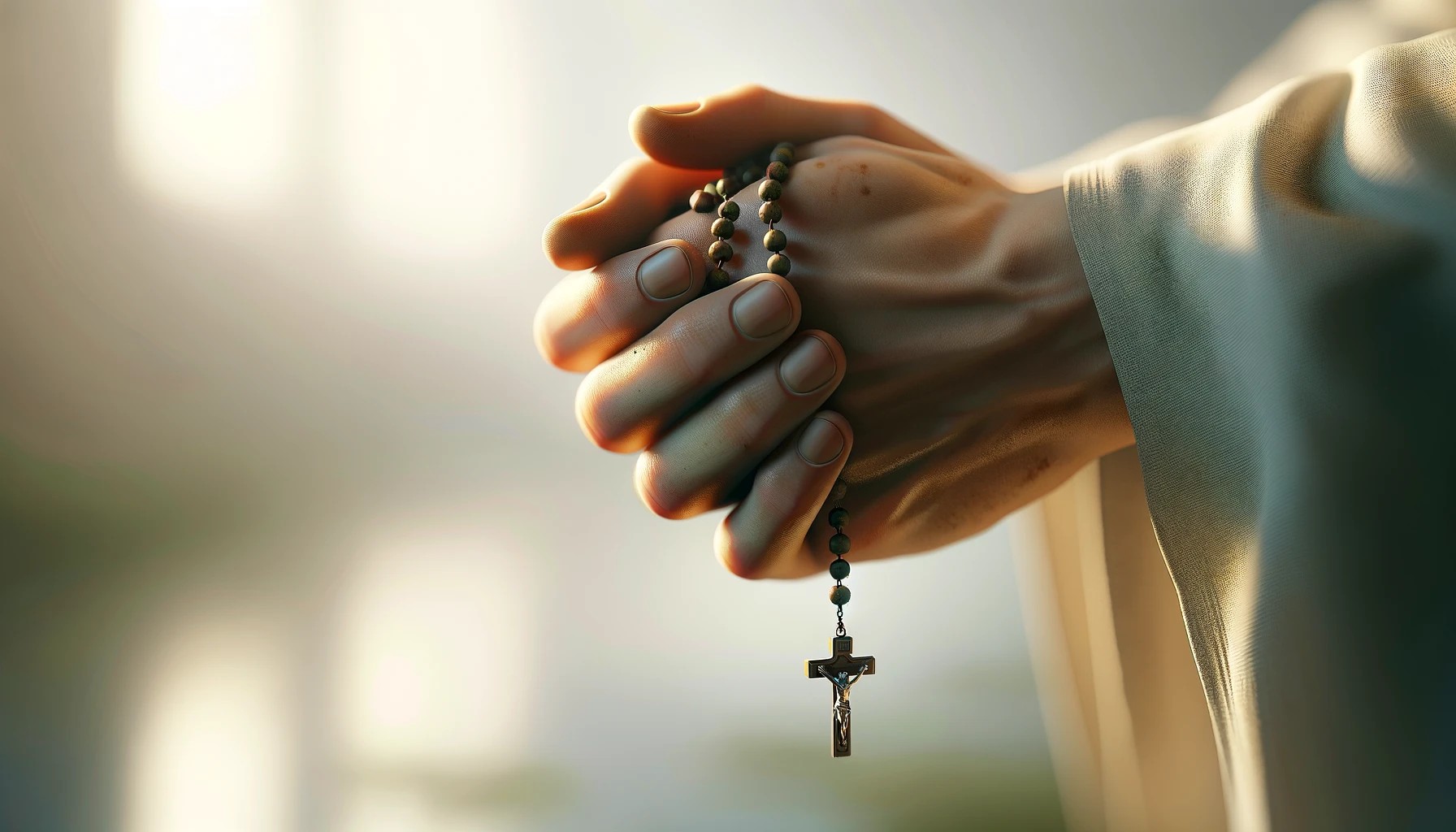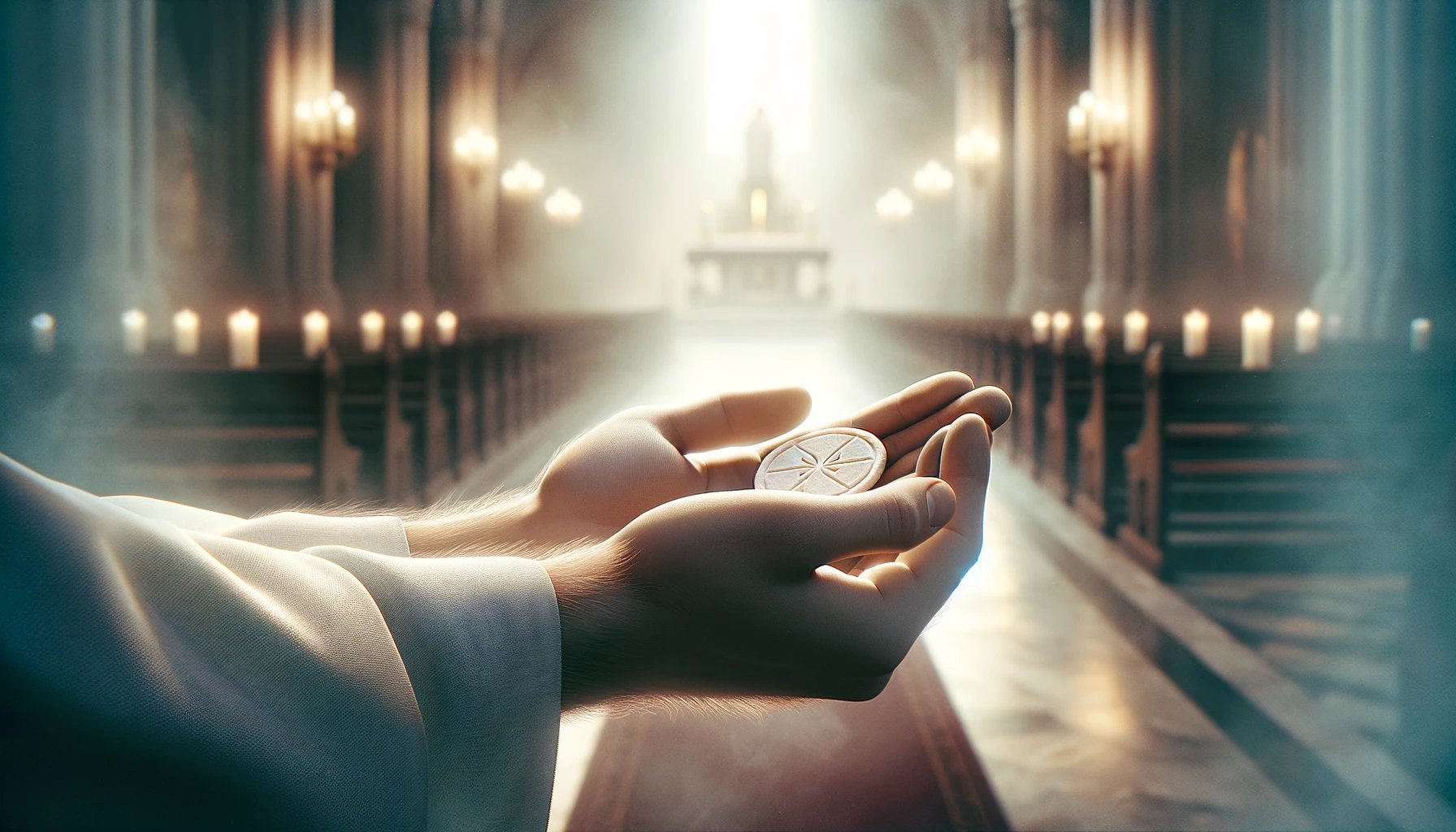Home>Theology and Spirituality>Kneeling When Receiving Communion


Theology and Spirituality
Kneeling When Receiving Communion
Published: February 25, 2024
Peter Smith, Editorial Director at Christian.net, combines deep insights into faith, politics, and culture to lead content creation that resonates widely. Awarded for his contributions to religious discourse, he previously headed a major organization for religious communicators, enhancing dialogue on faith's societal impacts.
Learn about the significance of kneeling during communion and its theological and spiritual implications. Explore the traditions and beliefs surrounding this practice. Gain insights into the theology and spirituality of kneeling during communion.
(Many of the links in this article redirect to a specific reviewed product. Your purchase of these products through affiliate links helps to generate commission for Christian.net, at no extra cost. Learn more)
Table of Contents
Introduction
Kneeling when receiving communion is a practice deeply rooted in the traditions of many Christian denominations. This act of reverence and humility holds significant theological and spiritual implications, reflecting the believers' reverence for the Eucharist and their posture of submission before the divine presence.
Throughout history, the act of kneeling during communion has been a subject of theological debate and cultural significance. Understanding the historical, theological, and contemporary perspectives surrounding this practice provides valuable insights into its profound meaning and relevance in the modern Christian faith.
In this article, we will delve into the historical background of kneeling during communion, exploring its evolution and cultural significance over the centuries. Additionally, we will examine the theological significance of this practice, shedding light on its symbolic representation of faith and reverence in the Christian tradition. Furthermore, we will explore contemporary practices and diverse views on kneeling during communion, considering the varying perspectives within different Christian communities.
By examining the arguments for and against kneeling during communion, we aim to provide a comprehensive understanding of this practice and its implications in the context of Christian worship. Through this exploration, we seek to illuminate the multifaceted nature of this tradition and its enduring relevance in the spiritual lives of believers.
Join us on this insightful journey as we unravel the rich tapestry of historical, theological, and contemporary perspectives surrounding the act of kneeling during communion, gaining a deeper appreciation for its profound significance in the Christian faith.
Read more: Should You Kneel When Receiving Communion
Historical Background of Kneeling During Communion
The act of kneeling during communion has a rich historical lineage, tracing back to the early centuries of Christianity. In the early Christian era, kneeling was not the predominant posture for receiving communion. Instead, standing was the customary posture, symbolizing the resurrection and the exalted state of Christ. This practice was deeply rooted in the cultural and theological context of the time, reflecting the joy and triumph of the Christian faith.
However, the practice of kneeling gradually emerged as a gesture of reverence and humility, particularly in the Western Church. Historical records indicate that by the early Middle Ages, kneeling had become the prevalent posture for receiving communion in the Latin Church. This shift in posture was influenced by a growing emphasis on the real presence of Christ in the Eucharist and the desire to express profound reverence for the sacred elements.
The Council of Rouen in 878 is among the earliest documented instances where kneeling during communion was prescribed. This decree marked a significant turning point in the historical development of this practice, as it formalized the act of kneeling as a sign of adoration and submission before the body and blood of Christ.
During the medieval period, the theological and liturgical significance of kneeling during communion continued to evolve. The act of kneeling became intertwined with the doctrine of transubstantiation, which asserts the transformation of the bread and wine into the actual body and blood of Christ during the Eucharistic celebration. This theological understanding further reinforced the practice of kneeling as a tangible expression of reverence for the divine presence in the Eucharist.
The Council of Trent in the 16th century solidified the practice of kneeling during communion as a normative posture in the Roman Catholic Church. This formal endorsement further entrenched the historical trajectory of kneeling as an integral aspect of the Eucharistic liturgy, shaping the devotional practices of countless believers for centuries to come.
In summary, the historical background of kneeling during communion reflects a nuanced evolution shaped by theological, cultural, and liturgical influences. This historical journey provides valuable insights into the enduring significance of this practice and its profound connection to the spiritual heritage of the Christian faith.
Theological Significance of Kneeling During Communion
The act of kneeling during communion carries profound theological significance, serving as a visible expression of faith, reverence, and humility within the Christian tradition. At the heart of this theological significance lies the belief in the real presence of Christ in the Eucharist, a cornerstone of sacramental theology across various Christian denominations.
Kneeling during communion embodies the believers' acknowledgment of the sacred mystery of the Eucharist, where the bread and wine are understood to become the body and blood of Christ. This act of physical prostration before the consecrated elements symbolizes the believers' reverence for the divine presence and their submission to the transformative power of the Eucharistic sacrifice.
Furthermore, the theological significance of kneeling during communion is intricately linked to the doctrine of transubstantiation, particularly within the Roman Catholic and Eastern Orthodox traditions. According to this doctrine, the substance of the bread and wine is believed to be substantially changed into the body and blood of Christ while retaining the outward appearance of bread and wine. Kneeling during communion thus becomes a tangible expression of adoration for the incarnate Christ, present in the Eucharistic elements.
In addition, the act of kneeling reflects the believers' participation in the paschal mystery, encompassing the life, death, and resurrection of Christ. By assuming a posture of humility and reverence, the faithful align themselves with the redemptive sacrifice of Christ, embracing the transformative power of the Eucharist in their lives.
Moreover, from a theological perspective, kneeling during communion underscores the believers' unity in Christ and their communal participation in the body of Christ. This act of collective reverence fosters a sense of spiritual solidarity and shared devotion, reinforcing the bonds of fellowship within the worshipping community.
Ultimately, the theological significance of kneeling during communion transcends mere physical posture; it embodies the believers' profound encounter with the living Christ in the Eucharist, affirming their faith in the transformative power of the sacrament and their unwavering reverence for the divine presence. This theological depth infuses the act of kneeling with profound spiritual meaning, enriching the believers' experience of communion and deepening their connection to the sacred mysteries of the Christian faith.
Contemporary Practices and Views on Kneeling During Communion
In contemporary Christian worship, the practice of kneeling during communion encompasses a diverse spectrum of practices and views across different denominations and local congregations. While some traditions uphold the longstanding custom of kneeling as an integral part of the Eucharistic liturgy, others have adopted alternative postures or offer flexibility in posture based on individual preferences and theological convictions.
Within the Roman Catholic Church, kneeling during communion remains the normative posture for receiving the Eucharist. This practice is deeply ingrained in the liturgical tradition of the Roman Rite, reflecting the Church's reverence for the real presence of Christ in the consecrated elements. The act of kneeling is often accompanied by a profound sense of devotion and solemnity, underscoring the believers' reverence for the Eucharistic sacrifice.
In contrast, many Protestant denominations, such as Anglican, Lutheran, and Methodist traditions, exhibit a range of practices regarding kneeling during communion. While some congregations maintain the practice of kneeling as a sign of reverence and humility, others embrace standing or sitting as alternative postures for receiving the Eucharist. These variations in posture reflect the diverse theological perspectives and liturgical expressions within these traditions, allowing for a degree of flexibility in worship practices.
Furthermore, in contemporary Christian worship settings, the question of kneeling during communion has sparked thoughtful dialogue and differing viewpoints among theologians, clergy, and congregants. Some advocate for the retention of kneeling as a powerful symbol of reverence and adoration, emphasizing its continuity with historical tradition and theological significance. Others, however, advocate for a more inclusive approach, recognizing that physical limitations or personal convictions may lead individuals to prefer alternative postures, such as standing or sitting, during the reception of communion.
Additionally, the contemporary landscape of Christian worship has witnessed the emergence of inclusive and accessible approaches to communion, accommodating diverse physical abilities and spiritual sensibilities. In some congregations, the option to receive communion while standing or sitting is extended to accommodate individuals who may find kneeling challenging due to age, physical disabilities, or other health-related reasons. This inclusive approach seeks to honor the spiritual dignity of all worshippers, ensuring that the act of receiving communion remains a meaningful and accessible experience for every member of the faith community.
In summary, contemporary practices and views on kneeling during communion reflect a tapestry of diverse traditions, theological perspectives, and pastoral considerations within the Christian faith. While the practice of kneeling holds deep historical and theological roots, the contemporary landscape of Christian worship embraces a spectrum of postures and inclusive approaches, affirming the rich diversity of expressions within the body of Christ. This dynamic interplay of tradition, theology, and pastoral sensitivity continues to shape the evolving practices and views surrounding the act of kneeling during communion in the modern Christian context.
Arguments For and Against Kneeling During Communion
Read more: When Should Catholics Kneel After Communion
Arguments For Kneeling During Communion
-
Reverence and Adoration: Proponents of kneeling during communion emphasize the profound reverence and adoration it signifies towards the real presence of Christ in the Eucharist. The act of kneeling is viewed as a tangible expression of humility and awe before the sacred mystery of the Eucharistic sacrifice.
-
Historical Continuity: Advocates for kneeling highlight its historical continuity within the Christian tradition, tracing back to the early centuries of the Church. They argue that maintaining this practice honors the rich heritage of Christian worship and upholds a sense of connection with the faith's historical roots.
-
Theological Significance: Supporters of kneeling underscore its theological significance as a visible affirmation of the doctrine of transubstantiation, particularly within the Roman Catholic and Eastern Orthodox traditions. Kneeling is seen as a powerful embodiment of the believers' faith in the real presence of Christ in the consecrated elements.
-
Unity and Communal Witness: Proponents of kneeling during communion emphasize its role in fostering a sense of communal unity and shared devotion within the worshipping community. The collective act of kneeling is viewed as a powerful symbol of the believers' shared faith and their participation in the body of Christ.
Arguments Against Kneeling During Communion
-
Inclusivity and Accessibility: Opponents of kneeling argue that the practice may pose challenges for individuals with physical limitations, disabilities, or health concerns, making it difficult or uncomfortable for them to kneel during communion. They advocate for alternative postures to ensure the inclusivity and accessibility of the Eucharistic celebration.
-
Cultural and Contextual Sensitivity: Critics of kneeling during communion emphasize the need for cultural and contextual sensitivity in worship practices. They contend that in certain cultural contexts or contemporary worship settings, alternative postures such as standing or sitting may better resonate with the worshippers and reflect their spiritual expressions.
-
Personal Piety and Convictions: Some individuals hold personal convictions or theological perspectives that lead them to prefer alternative postures during communion. They advocate for the freedom to choose a posture that aligns with their spiritual sensibilities, emphasizing the diversity of worship expressions within the body of Christ.
-
Emphasis on the Inner Disposition: Opponents of kneeling underscore the primacy of the inner disposition of the worshippers during communion, emphasizing that the posture, whether kneeling, standing, or sitting, should not overshadow the internal reverence and devotion towards the Eucharistic mystery. They advocate for a focus on the spiritual attitude rather than the physical posture.
In the dynamic discourse surrounding the practice of kneeling during communion, these diverse arguments reflect the multifaceted considerations and convictions within the Christian community, shaping the ongoing dialogue and discernment regarding worship practices and theological expressions.
Conclusion
The act of kneeling during communion embodies a rich tapestry of historical, theological, and contemporary significance within the Christian faith. From its early roots in the traditions of the Church to its enduring theological depth, the practice of kneeling during communion reflects the believers' reverence for the Eucharistic sacrifice and their profound encounter with the real presence of Christ in the consecrated elements.
Throughout history, the act of kneeling has evolved as a visible expression of faith, humility, and adoration, shaping the devotional practices of diverse Christian traditions. Its historical continuity underscores the enduring connection to the early centuries of Christianity, honoring the rich heritage of Christian worship and the theological depth of the Eucharistic mystery.
The theological significance of kneeling during communion resonates with the belief in the real presence of Christ in the Eucharist, emphasizing the transformative power of the sacrament and the believers' participation in the paschal mystery. This act of physical prostration embodies the believers' unity in Christ and their communal witness to the sacred mysteries of the faith, fostering a sense of spiritual solidarity and shared devotion within the worshipping community.
In contemporary Christian worship, the practice of kneeling during communion reflects a spectrum of practices and views, encompassing diverse traditions, theological perspectives, and pastoral considerations. While some traditions uphold the practice as a powerful symbol of reverence and adoration, others advocate for inclusive and accessible approaches, recognizing the diverse spiritual sensibilities and physical abilities within the faith community.
The discourse surrounding the arguments for and against kneeling during communion highlights the multifaceted considerations and convictions within the Christian community, shaping the ongoing dialogue and discernment regarding worship practices and theological expressions. This dynamic interplay of tradition, theology, and pastoral sensitivity underscores the evolving nature of Christian worship, embracing a diversity of postures and inclusive approaches while honoring the theological depth and historical legacy of the Eucharistic tradition.
In conclusion, the act of kneeling during communion stands as a profound embodiment of faith, reverence, and unity within the Christian tradition, weaving together the threads of history, theology, and contemporary worship practices. Its enduring significance illuminates the spiritual journey of believers, inviting them to encounter the living Christ in the Eucharist and to embrace the transformative power of the sacred mysteries with hearts uplifted in reverence and awe.














